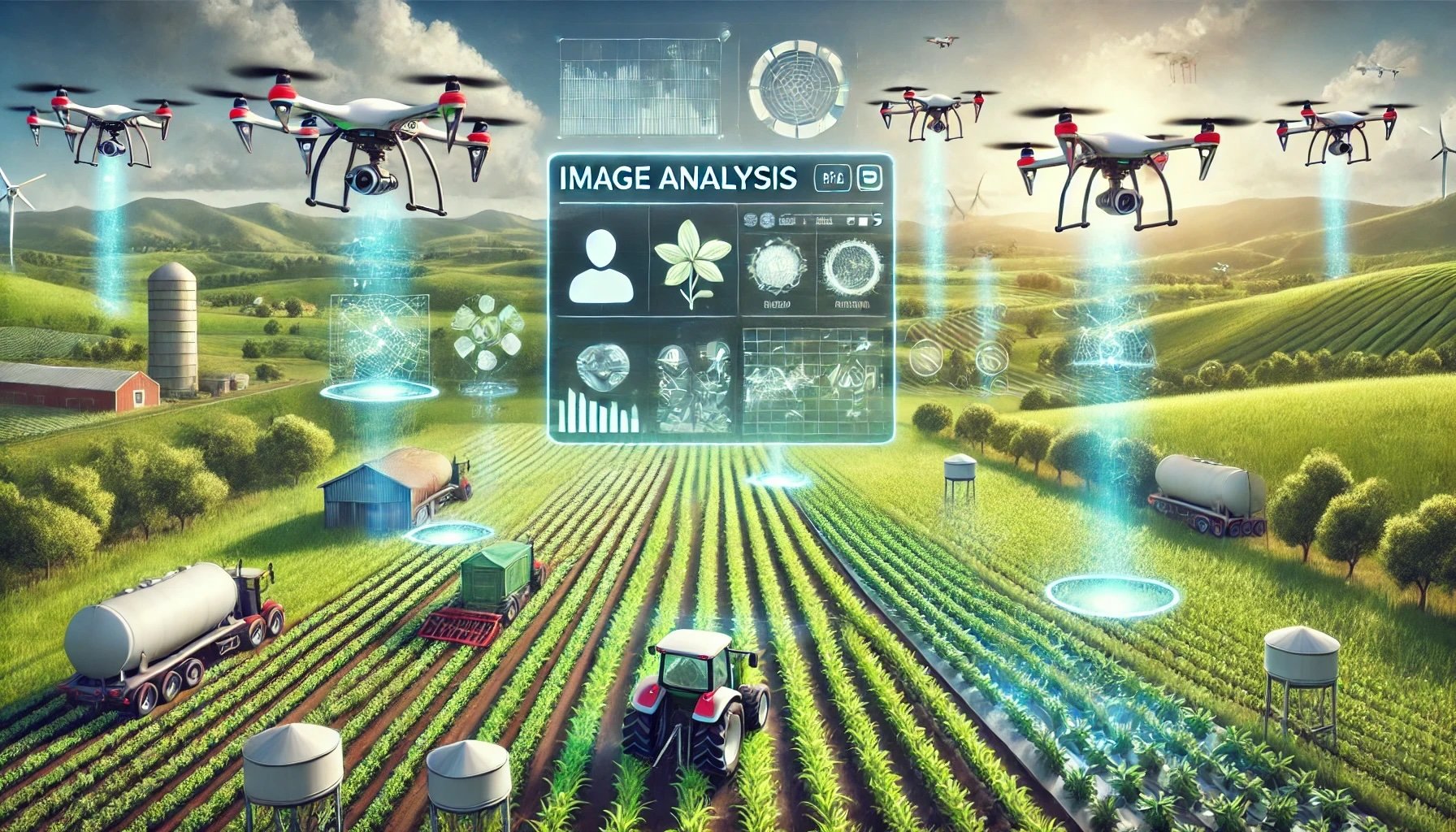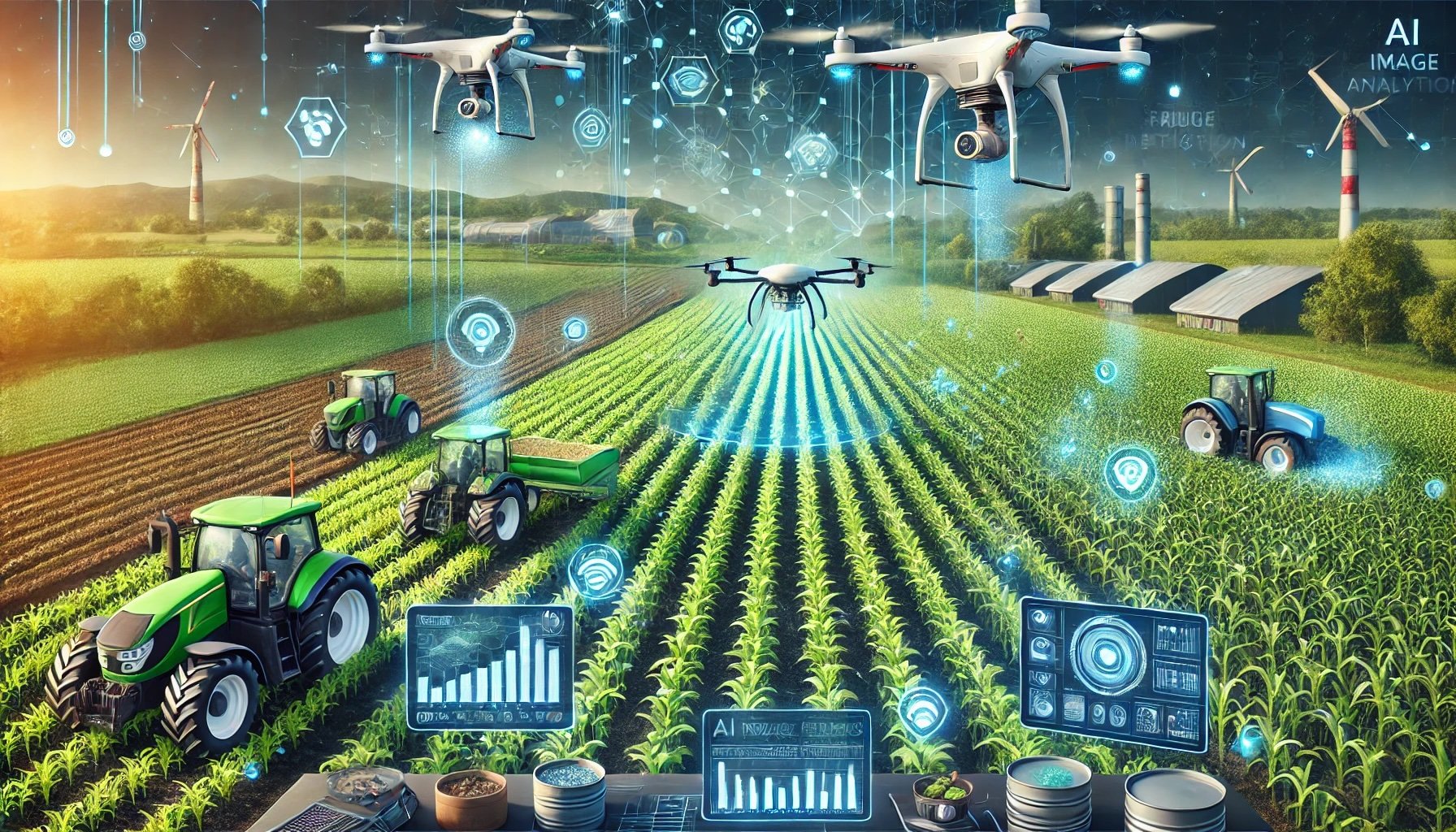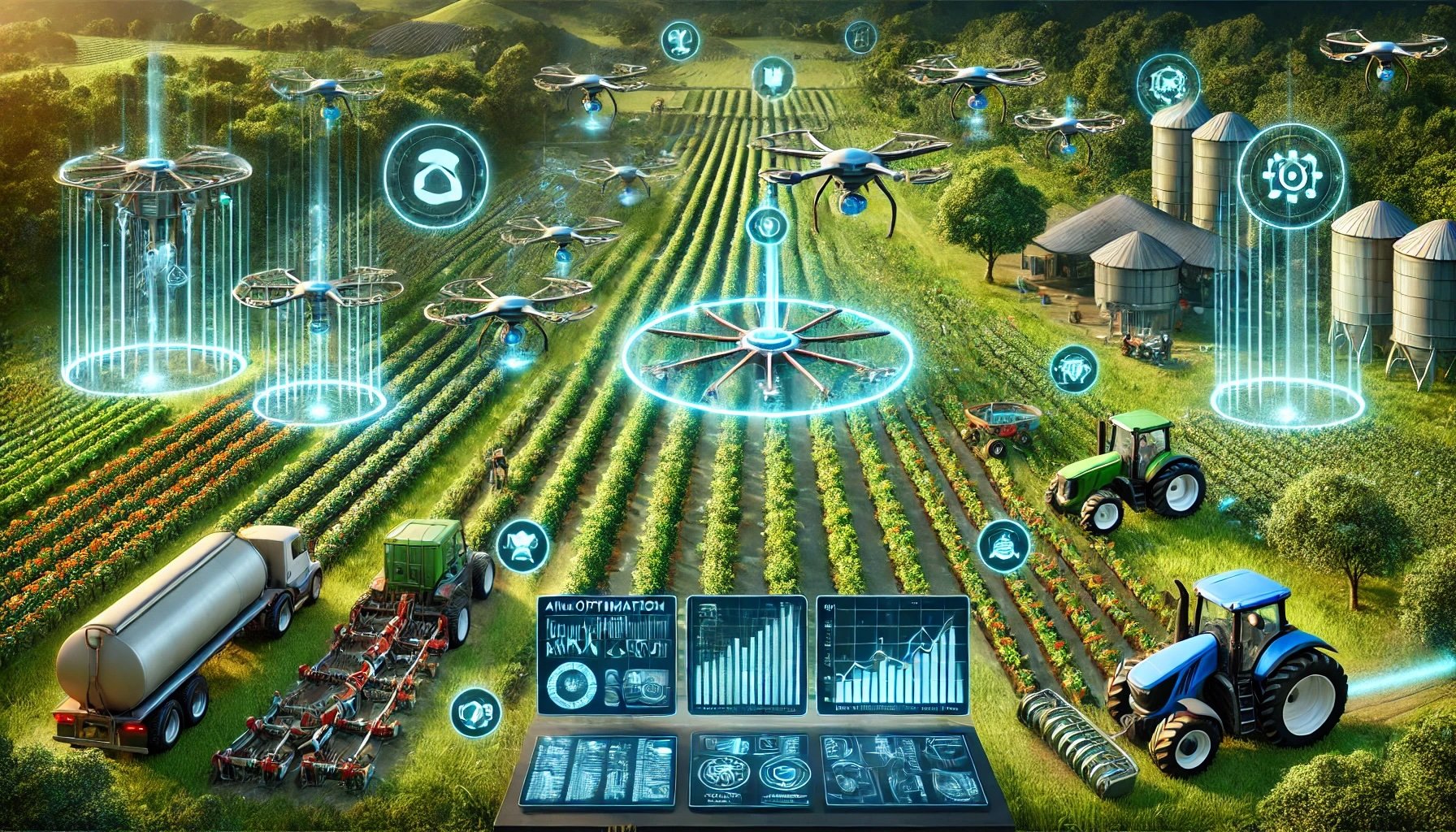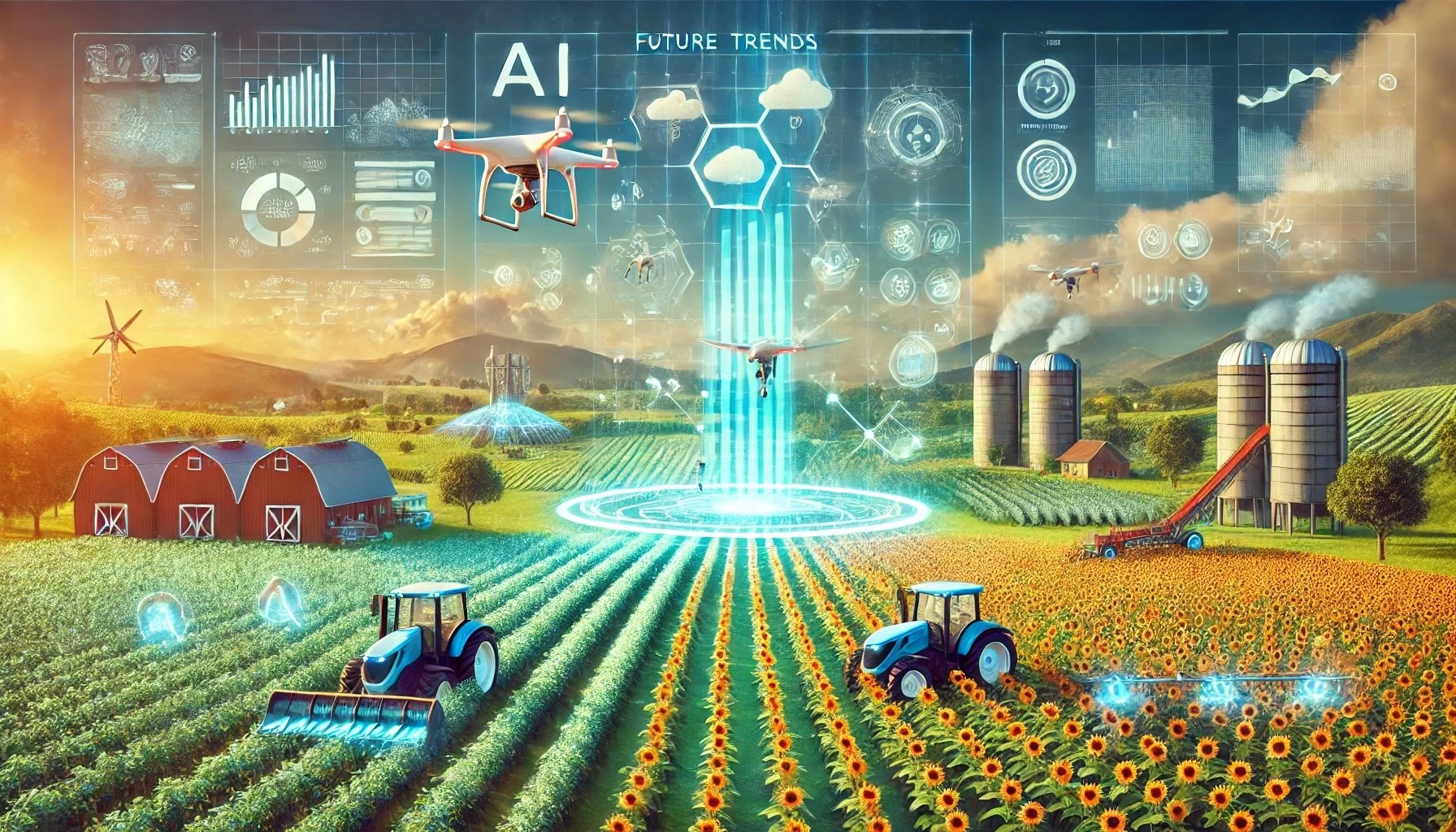Boosting Agricultural Productivity with AI-Powered Image Analysis
Introduction to AI in Agriculture
Agriculture has always been at the heart of human civilization, but the way we farm is undergoing a profound transformation thanks to technology. Gone are the days when farming relied solely on the sun, rain and the farmer's intuition. Today, technology is reshaping agriculture from the ground up, making it more efficient, sustainable and productive. Among the myriad of tech advancements, Artificial Intelligence (AI) stands out as a game-changer, particularly through its application in image analysis.
The evolution of agriculture with technology can be traced back to simple mechanization, like the plow and the tractor, to more complex systems such as precision farming where GPS technology guides machinery. Now, we're stepping into an era where AI not only automates but also intelligently analyzes and optimizes farming practices. AI's role in agriculture is multifaceted:
Enhancing Decision-Making: AI systems process vast amounts of data from various sources to provide farmers with detailed insights. This could range from soil health analysis to predicting weather patterns, helping farmers make informed decisions about planting, watering and harvesting.
Automation of Repetitive Tasks: From autonomous tractors to drones that monitor crop health, AI reduces the manual labor involved in farming, allowing for more precise and timely interventions.
Disease and Pest Management: AI algorithms can detect early signs of disease or pest infestations in crops through image analysis, enabling farmers to act swiftly to prevent outbreaks, thus saving time and reducing the need for chemical interventions.
Image analysis, powered by AI, is particularly crucial in modern agriculture. It involves the use of cameras, drones and satellites to capture images of fields, crops and livestock. These images are then analyzed to:
Monitor Crop Health: By examining color, texture and patterns in images, AI can spot early signs of diseases, nutrient deficiencies or water stress, allowing for targeted treatments rather than blanket applications.
Optimize Resource Use: Through detailed analysis, farmers can apply water, fertilizers and pesticides only where needed, reducing waste and environmental impact while potentially increasing yield.
Assess Growth and Yield: AI can estimate how well crops are growing and predict yield by analyzing images over time, helping farmers to better plan for harvest and market demands.
Quality Control: For products like fruits, vegetables or grains, AI can assess quality parameters directly from images, which can be critical for grading and pricing.
The importance of image analysis lies in its ability to provide a non-invasive, efficient way to gather data that would otherwise require extensive manual labor or less accurate traditional methods. It's like giving farmers a new set of eyes that see beyond human capabilities, offering a microscopic and macroscopic view of their fields at any given time. This technology not only increases productivity but also pushes the boundaries towards more sustainable farming practices by minimizing resource use and reducing human error.
As we delve deeper into this blog, we'll explore how these AI-powered tools are becoming integral to modern farming, offering insights that could lead to a revolution in how we grow our food.
Understanding Image Analysis in Farming
Image analysis technology in agriculture involves capturing visual data of fields, crops or livestock and then processing this data using sophisticated algorithms to extract meaningful information. At its core, image analysis in farming is about turning pictures into knowledge that farmers can use to improve their practices.
Definition and Explanation of Image Analysis Technology:
Image analysis technology uses various tools like cameras, drones, satellites or even smartphone apps to take pictures or videos of agricultural settings. These images are then fed into AI systems where they're examined pixel by pixel. The technology breaks down images into components like color, shape, texture and patterns. These elements are the clues that AI uses to understand what's happening in the field or with the crops:
Cameras and Sensors: On the ground or mounted on drones or vehicles, these capture high-resolution images or even infrared data which can reveal health issues not visible to the naked eye.
Satellite Imagery: Offers a broader view, useful for monitoring large areas over time for changes in land use, crop growth or soil moisture levels.
Machine Learning Algorithms: These are the heart of AI image analysis, learning from datasets to recognize and interpret what they see in new images, getting better with each analysis.
How AI Interprets Images to Provide Actionable Insights:
AI interprets images by comparing what it sees to what it has learned from previous images or data inputs. Here's how it works:
Pattern Recognition: AI can identify patterns in crop rows, soil textures or even the spread of pests. By spotting anomalies, it can alert farmers to take action before small issues become big problems.
Time-series Analysis: By analyzing images taken at different times, AI can track growth, detect changes in plant health or predict when crops will be ready for harvest.
Data Correlation: AI doesn't just look at images in isolation. It can correlate image data with other information like weather data or historical yield records to provide more nuanced insights.
Examples of Data Extracted from Images:
Plant Health: Changes in leaf color, texture or structure can indicate nutrient deficiencies, disease or stress. AI can pinpoint these areas for immediate attention.
Example: A field showing patches of yellowing leaves might be suffering from a nitrogen deficiency, prompting a targeted fertilizer application.Soil Condition: Images can reveal soil moisture levels, erosion patterns or even soil type through color and texture analysis.
Example: Darker areas in an image might indicate waterlogged soil, suggesting a need for better drainage solutions.Pest Presence: AI can detect signs of pests or damage they cause, like holes in leaves or unusual colorations.
Example: An AI might notice an unusual texture on leaves, signaling the early presence of aphids, allowing for early intervention.Crop Growth Stages: By analyzing size, color and density changes in crops over time, AI can estimate growth stages or yield predictions.
Example: Images showing a certain height and color of corn plants could indicate it's nearing the optimal harvest time.Livestock Health: For animal farming, AI can analyze images of livestock to monitor health, detect injuries or assess body condition.
Example: An AI system might flag an animal with a limp or unusual posture for closer veterinary inspection.
By harnessing the power of image analysis, farmers can move from a reactive to a proactive approach, managing their land and livestock with unprecedented precision. This not only boosts productivity but also supports environmentally friendly practices by reducing the overuse of resources like water, chemicals or labor.
Key Applications of AI Image Analysis
AI image analysis in agriculture is transforming how farmers manage their crops and livestock, offering solutions that are both precise and timely. Here's a look at some of the pivotal ways this technology is being applied:
Crop Health Monitoring:
Monitoring the health of crops is crucial for maintaining yield and quality. AI image analysis provides an efficient way to:
Detect Diseases Early: AI can analyze images to identify early signs of plant diseases, which might not be visible to the human eye. For instance, changes in leaf color or texture can indicate fungal infections or viral diseases. Early detection allows for timely interventions, potentially saving entire crops.
Assess Plant Stress: Whether it's from drought, excessive heat or nutrient deficiencies, plants under stress show specific signs in their visual appearance. AI can pick up these subtle cues, like wilting or discoloration, helping farmers to adjust irrigation or fertilization practices before significant damage occurs.
Predict Yield: By continuously analyzing growth patterns and health indicators throughout the season, AI can estimate the likely yield. This predictive insight is invaluable for planning harvest, logistics and market strategies.
Precision Agriculture:
Precision agriculture is all about doing more with less, by tailoring the use of resources to meet the exact needs of the crop:
Water Management: AI analysis of soil and plant images can guide precise irrigation. By understanding which parts of a field are dry or waterlogged, water can be applied exactly where it's needed, conserving this precious resource.
Fertilizer Application: Nutrient needs vary across a field. AI can detect areas where crops show signs of deficiency or surplus, allowing for targeted fertilizer applications that reduce waste and environmental impact while boosting plant health.
Pesticide Use: Instead of blanket spraying, AI can identify specific areas or even individual plants affected by pests, enabling spot treatments that minimize chemical use and exposure, protecting both the environment and farm workers.
Weed and Pest Detection:
Managing weeds and pests is a never-ending battle in farming, but AI makes it more strategic:
Weed Identification: AI can differentiate between crops and weeds, even at early growth stages, facilitating mechanical or chemical weeding only where necessary. This reduces the labor and cost associated with weed control.
Pest Management: Through image analysis, AI can spot pest infestations or damage signs before they become widespread. This allows for targeted pest control measures, often using biological agents or minimal chemical intervention, reducing the ecological footprint.
Harvest Timing and Quality Assessment:
Getting the harvest timing right can significantly affect crop quality and market price:
Optimal Harvest Time: AI can analyze the color, size and density of fruits or grains to determine the best moment for picking. For example, in vineyards, AI can assess grape ripeness for wine production, ensuring the harvest captures the peak of flavor and sugar content.
Quality Control: Before even reaching the market, AI can grade produce based on visual characteristics like size, color uniformity and signs of damage or disease. This not only aids in quality assurance but also in sorting for different market segments or processing needs.
These applications illustrate how AI image analysis is not just a tool but a transformative force in agriculture. It empowers farmers with data-driven insights, leading to more sustainable practices, higher efficiency and potentially better financial outcomes. By harnessing these capabilities, the agricultural sector can address some of its most pressing challenges, from resource management to climate adaptation.
The Impact of AI on Agricultural Efficiency
The integration of AI in agriculture, particularly through image analysis, has profound implications for farm efficiency. Here's how this technology is revolutionizing the sector:
Reduction in Resource Use through Precision:
Water Management: AI helps in optimizing irrigation by analyzing soil moisture and plant water stress through images. This precision leads to a significant reduction in water use, as farmers can water only where and when it's needed, rather than employing blanket irrigation methods. This not only conserves water but also prevents issues like waterlogging or nutrient leaching.
Chemical Inputs: The precise application of fertilizers and pesticides, guided by AI's ability to detect specific plant needs or pest hotspots, means less chemical is used overall. This targeted approach reduces environmental impact, saves costs for farmers and minimizes the health risks associated with chemical exposure. For instance, AI can identify areas with nutrient deficiencies, allowing for exact spot treatments rather than broad applications.
Labor Savings and Cost Efficiency:
Automation and Task Reduction: AI-driven systems can take over repetitive or labor-intensive tasks like monitoring fields for pests or diseases, which traditionally require human labor. Autonomous drones or robots equipped with image analysis capabilities can survey vast areas quickly, reducing the need for manual checks. This not only saves on labor costs but also speeds up response times to agricultural challenges.
Operational Efficiency: With AI, farmers can manage larger areas with fewer resources. Data from image analysis can be used for better planning and execution, from planting to harvest, reducing operational costs. For example, AI can optimize machine paths for efficiency or predict maintenance needs, thus reducing downtime.
Improvement in Crop Yield and Quality Leading to Better Market Outcomes:
Yield Enhancement: By addressing plant health issues promptly and tailoring resource allocation, AI contributes to healthier crops, which in turn leads to higher yields. Predictive analytics on crop growth and health can inform decisions that maximize productivity, ensuring that each plant reaches its full potential.
Quality Improvement: AI image analysis allows for meticulous quality control. By assessing produce before harvest, farmers can ensure that only the highest quality items reach the market. This not only fetches better prices but also builds a reputation for quality, strengthening market positions. For example, in fruit farming, AI can sort fruits based on size, color and defect, directly impacting market value.
Market Timing: With AI's ability to predict optimal harvest times, farmers can hit the market when prices are most favorable. This precision in timing, based on crop maturity and quality analysis, can lead to better financial outcomes by aligning supply with demand more effectively.
Sustainability and Brand Value: Farmers employing AI for sustainable practices can market their produce under eco-friendly or precision agriculture labels, which are increasingly valued by consumers. This not only potentially increases revenue but also aligns agricultural practices with global sustainability goals, enhancing the brand value in the eyes of environmentally conscious markets.
The overarching impact of AI on agricultural efficiency is a move towards a smarter, more responsive and sustainable farming model. By reducing waste, cutting costs and improving both yield and quality, AI is not just about doing more with less; it's about doing it better, ensuring that agricultural practices can meet the demands of an ever-growing, environmentally conscious global population.
Technological Innovations in Agricultural Image Analysis
The field of agricultural image analysis is experiencing a wave of technological advancements that are pushing the boundaries of what's possible in farming. Here's an exploration of how these innovations are shaping the future of agriculture:
Advancements in AI Algorithms for Better Image Recognition and Data Processing:
Enhanced Image Recognition: Modern AI algorithms are becoming more adept at recognizing complex patterns in agricultural images. Techniques like Convolutional Neural Networks (CNNs) have improved dramatically, allowing for precise identification of crop types, diseases and even subtle signs of stress or nutrition deficiencies that were once hard to detect. These algorithms learn from vast amounts of data to provide more accurate and nuanced insights.
Efficient Data Processing: With the increase in data from high-resolution images, there's a need for faster processing. New algorithms are optimized for speed, enabling real-time analysis which is crucial for timely agricultural decisions. This includes techniques for data compression without loss of critical information, ensuring that AI can handle the high data load from modern farming operations.
New Types of Sensors and Cameras for Enhanced Image Quality:
Hyperspectral Imaging: This technology captures images in many narrow spectral bands, providing a detailed view of plant health by analyzing how different wavelengths of light are absorbed or reflected. It's particularly useful for detecting plant stress or disease long before they're visible to the human eye.
Thermal Cameras: These cameras detect heat signatures which can reveal water stress, irrigation issues or even pest activity underneath the soil surface. They're invaluable for nighttime monitoring or for assessing crops under varying environmental conditions.
Multispectral Sensors: Used in drones or satellites, these sensors capture images across several specific wavelengths, offering insights into plant health, soil moisture and more, enhancing the accuracy of AI analyses.
Developments in AI Model Training with Agricultural-Specific Datasets:
Specialized Datasets: Creating and utilizing datasets that are specifically tailored to agricultural scenarios has been a game-changer. These datasets include images from various crops, under different conditions, across seasons and from different regions. This specificity allows AI models to learn from scenarios directly relevant to farming, improving the reliability of their predictions and analyses.
Continuous Learning: AI models are now designed to learn continuously from new data, adapting over time. This means as farming practices evolve or new crop varieties are introduced, the AI can update its understanding without needing extensive retraining, making it more practical for long-term use in agriculture.
Exploration of Machine Learning Techniques like Deep Learning:
Deep Learning for Nuanced Interpretation: Deep learning models, especially those employing neural networks with many layers, can interpret images with unprecedented depth. They can discern not just what is in an image but also how elements relate to each other, such as how the health of one plant might affect its neighbors or how certain patterns of leaves indicate specific diseases.
Segmentation and Feature Extraction: Advances in these areas allow AI to segment images into meaningful parts (like individual plants or parts of plants) and extract features for analysis (like leaf vein patterns or fruit ripeness). This granularity supports more precise agricultural practices.
Transfer Learning: This technique allows AI to apply knowledge from one domain to another, speeding up the learning process for new agricultural challenges by adapting models previously trained on similar but different tasks or datasets.
These technological strides in AI and image analysis are not just enhancing our ability to see and understand agricultural landscapes but are fundamentally changing how we interact with and manage them. By providing farmers with tools that offer deeper, faster and more accurate insights, these innovations are paving the way for a more efficient, sustainable and productive agricultural sector.
Future Trends and Opportunities
The convergence of AI-powered image analysis with other technological trends is poised to redefine agriculture in ways that were once the domain of science fiction. Here's a look at where this journey might lead:
Predictive Analytics for Weather and Market Trends Based on Image Data:
Weather Prediction: By combining image analysis with weather data, AI can forecast local weather patterns with greater accuracy, particularly microclimates within a farm. This could mean predicting frost, excessive rain or drought at a small scale, allowing farmers to adjust their practices proactively to safeguard crops.
Market Insights: AI can analyze current crop conditions from images and correlate this with historical market data to predict price trends. For instance, by assessing the health and growth rate of a crop, farmers could anticipate market saturation or scarcity, optimizing when to sell their produce for maximum profit.
Integration with IoT Devices for Real-Time Field Management:
Smart Farming Ecosystems: The integration of AI image analysis with IoT (Internet of Things) devices like soil sensors, weather stations and automated irrigation systems creates a responsive farming ecosystem. This allows for real-time data collection and action, where adjustments to water, light or nutrients can be made automatically based on the latest image data.
Drones and Robotics: IoT devices will work in tandem with drones that capture images and robots that can perform tasks from planting to weeding based on AI's directives. This real-time management reduces human error, labor and time, while increasing precision and responsiveness to field conditions.
Potential for Custom AI Solutions to Address Niche Agricultural Challenges:
Tailored Applications: Not all farms are the same and custom AI solutions can be developed to address specific challenges like managing unique crop varieties, local pest species or particular soil types. This customization can lead to more effective solutions that generic tools might not cover.
Scalability and Flexibility: As AI solutions become more accessible, even small to medium-sized farms can benefit from bespoke AI tools, leveling the playing field in terms of technological adoption and innovation.
Discussion on How These Technologies Could Shape the Future of Farming:
Sustainability: AI-driven agriculture promises a significant reduction in resource use, from water to chemicals, promoting more sustainable farming practices. By optimizing inputs and reducing waste, farms can operate with a lower environmental footprint while maintaining or even increasing productivity.
Food Security: With the ability to predict and manage crop health more effectively, we can expect increased yield stability and quality. This technology can be particularly transformative in regions prone to climate variability, helping to ensure food supply even under challenging conditions.
Economic Viability: Farms adopting these technologies might see a reduction in costs due to precision agriculture, leading to more economically viable operations. This could encourage more people to enter or stay in farming, potentially reversing trends of farm consolidation.
Community and Consumer Impact: As farming becomes more transparent through data, consumers might gain better insights into where their food comes from, fostering trust and supporting local or sustainable farming practices. This could lead to stronger community-supported agriculture and a push for more ethical food sourcing.
Global Reach: The technologies discussed can be adapted for use across different agricultural landscapes globally, aiding in the fight against global hunger by enhancing productivity in less developed agricultural sectors.
In essence, the future of farming with AI and image analysis looks set to be one where technology not only boosts productivity but also fosters sustainability, equity and resilience in food production. These trends and opportunities signal a shift towards an agriculture that's not just about feeding a growing population but doing so in a way that respects our planet's limits and diversity.
Conclusion: Embracing AI for Sustainable Agriculture
As we've explored throughout this post, the integration of AI, particularly through image analysis, into agriculture isn't just an enhancement; it's a revolution of how we approach farming. Here's a recap of the myriad benefits AI brings to the table:
Efficiency and Precision: AI reduces the guesswork in farming by providing clear, data-driven insights into crop health, soil conditions and resource management. This precision leads to less waste, more efficient use of inputs like water and chemicals and ultimately, better yields with less environmental impact.
Labor and Cost Savings: Automated systems and predictive analytics mean less human labor is needed for routine tasks, lowering operational costs. This can make farming more economically viable for both large and small operations, potentially bringing new life to rural economies.
Resilience and Adaptability: With AI, farmers can be more responsive to changes in weather, market demands or pest invasions. This adaptability is crucial in an era where climate change and global market fluctuations are the norm.
Sustainability: By optimizing farming practices, AI contributes to sustainable agriculture, reducing the ecological footprint of farming activities. This is vital for long-term food security and preserving the environment for future generations.
Given these advantages, the adoption of AI in agriculture is not just advantageous; it's becoming essential for staying competitive in the modern farming landscape. Farms that leverage AI technology are positioned to:
Outperform competitors in terms of yield, quality and cost-efficiency.
Meet consumer demands for sustainably produced food, which is increasingly influencing market trends.
Navigate the complexities of modern agricultural challenges, including climate change, with more agility and foresight.
Here's the call to action for all involved in agriculture:
Explore AI Solutions for Your Farm: Now is the time to delve into how AI can transform your agricultural practices. Whether you're looking to monitor crop health, optimize resource use or predict market trends, AI offers tools tailored to your needs.
Consider Tailored AI Services: Remember, not all farms are the same and your challenges might require unique solutions. Exploring services that provide custom AI development can lead to solutions perfectly aligned with your specific agricultural challenges, enhancing your farm's productivity and sustainability.
This journey into AI isn't just about adopting new technology; it's about embracing a future where farming is smarter, more sustainable and more rewarding. By integrating AI into your operations, you're not only improving your farm's performance but also contributing to a global movement towards more responsible and efficient food production. Let's move forward together, leveraging the power of AI to ensure that agriculture thrives in harmony with our planet.






